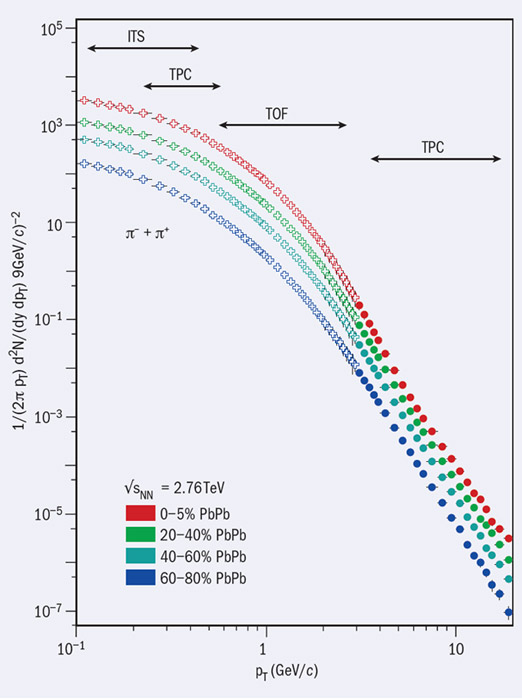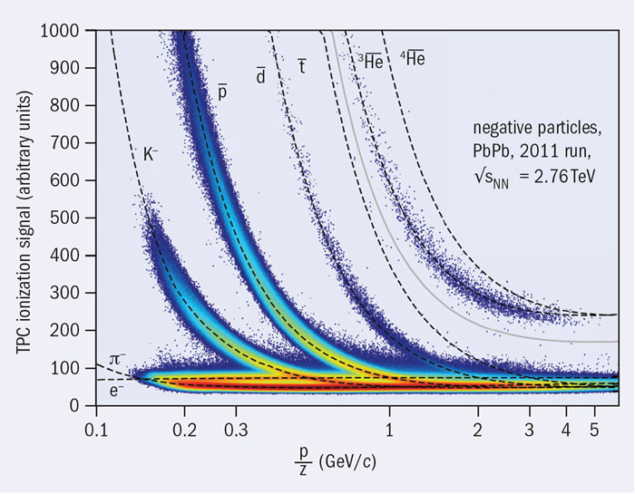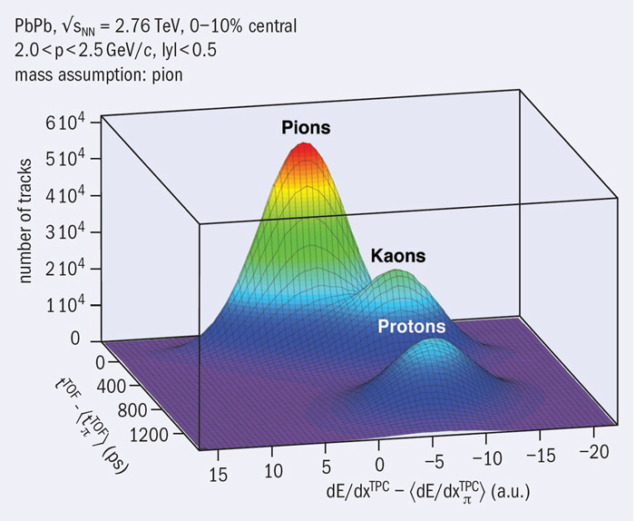How the experiment employs an arsenal of techniques.

Under extreme conditions of temperature and/or density, hadronic matter “melts” into a plasma of free quarks and gluons – the so-called quark–gluon plasma (QGP). To create these conditions in the laboratory, heavy ions (e.g. lead nuclei) are accelerated and made to collide head on, as was done at the LHC for two dedicated periods in 2010 and 2011. A key design consideration of the ALICE experiment at the LHC is the ability to study QCD and quark (de)confinement under these extreme conditions. This is done by using particles – created inside the hot volume as it expands and cools down – that live long enough to reach the sensitive detector layers located around the interaction region. The physics programme at ALICE relies on being able to identify all of them – i.e. to determine if they are electrons, photons, pions, etc – and to determine their charge. This involves making the most of the (sometimes slightly) different ways that particles interact with matter. This article gives an overview of the methods used for particle identification (PID) and their implementations in ALICE and describes how new technologies were used to push the state of the art.
Penetrating muons
Muons can be identified by the fact that they are the only charged particles able to pass almost undisturbed through any material. This is because muons with momenta below a few hundred GeV/c do not suffer from radiative energy losses and so do not produce electromagnetic showers. Also, being leptons, they are not subject to strong interactions with the nuclei of the material that they traverse. This behaviour is exploited in muon spectrometers in high-energy-physics experiments by installing muon detectors either behind the calorimeter systems or behind thick absorber materials. All other charged particles are completely stopped, producing electromagnetic (and hadronic) showers.
The muon spectrometer in the forward region of ALICE features a thick, complex front absorber and an additional muon filter comprising an iron wall 1.2 m thick. Muon candidates selected from tracks penetrating these absorbers are measured precisely in a dedicated set of tracking detectors. Pairs of muons are used to observe the full spectrum of heavy-quark vector-meson resonances (J/Ψ, …). Their production rates can be analysed as a function of transverse momentum and collision centrality to investigate dissociation arising from colour screening. In addition, muons from the semileptonic decay of open charm and open beauty can also be studied with the muon spectrometer.
Weighing particles
Hadron identification can be crucial for heavy-ion physics. Examples are open charm and open beauty, which allow the investigation of the mechanisms for the production, propagation and hadronization of heavy quarks in the hot and dense medium formed in the heavy-ion collisions. The most promising channel is the process D0 → K– π+, which requires efficient hadron identification owing to the small signal-to-background ratio.
Charged hadrons are unambiguously identified if their mass and charge are determined
Charged hadrons (in fact, all stable charged particles) are unambiguously identified if their mass and charge are determined. The mass can be deduced from measurements of the momentum and of the velocity. Momentum and the sign of the charge are obtained by measuring the curvature of the particle’s track in a magnetic field. To obtain the particle velocity there are four methods based on measurements of time-of-flight (TOF) and ionization, and on the detection of transition radiation (TR) and Cherenkov radiation. Each method works well in different momentum ranges or for specific types of particle. They are combined in ALICE to measure, for instance, particle spectra. Figure 1, for example, shows the abundance of pions in lead–lead (PbPb) collisions as a function of transverse momentum and collision centrality.
Kicking electrons from atoms
The characteristics of the ionization process caused by fast, charged particles passing through a medium can be used for PID. The velocity dependence of the ionization strength is connected to the Bethe-Bloch formula, which describes the average energy loss of charged particles through inelastic Coulomb collisions with the atomic electrons of the medium. Multiwire proportional counters (MWPCs) or solid-state counters are often used as the detection medium because they provide signals with pulse heights that are proportional to the ionization strength. Because energy-loss fluctuations can be considerable, in general many pulse-height measurements are performed along the particle track to optimize the resolution of the ionization measurement.
In ALICE this technique is used for PID in the large time-projection chamber (TPC) and in four layers of the silicon inner tracking system (ITS). A TPC is a large volume filled with a gas as the detection medium. Almost all of this volume is sensitive to the traversing charged particles but it features a minimum material budget. The straightforward pattern recognition (continuous tracks) makes TPCs the perfect choice for high-multiplicity environments, such as in heavy-ion collisions, where thousands of particles have to be tracked simultaneously. Inside the ALICE TPC, the ionization strength of all tracks is sampled up to 159 times, resulting in a resolution of the ionization measurement as good as 5%. Figure 2 shows the TPC ionization signal as a function of the particle rigidity for negative particles, indicating the different characteristic bands for various types of particle. A particle is identified when the corresponding point in the diagram can be associated with only one such band within the measurement errors. The method works well, especially for particles with low momenta up to several hundred MeV/c.

Using a stopwatch
TOF measurements yield the velocity of a charged particle by measuring the flight time over a given distance along the track trajectory. Provided the momentum is also known, the mass of the particle can then be derived from these measurements. The ALICE TOF detector is a large-area detector based on multigap resistive plate chambers (MRPCs) that cover a cylindrical surface of 141 m2, with an inner radius of 3.7 m. The MRPCs are parallel-plate detectors built of thin sheets of standard window glass to create narrow gas gaps with high electric fields. These plates are separated using fishing lines to provide the desired spacing; 10 gas gaps per MRPC are needed to arrive at a detection efficiency close to 100%.

The simplicity of the construction allows a large system to be built with an overall TOF resolution of 80 ps at a relatively low cost. This performance allows the separation of kaons, pions and protons up to momenta of a few GeV/c. Combining such a measurement with the PID information from the ALICE TPC has proved useful in improving the separation between the different particle types, as figure 3 shows for a particular momentum range.
Detecting additional photons
The identification of electrons and positrons in ALICE is achieved using a transition radiation detector (TRD). In a similar manner to the muon spectrometer, this system enables detailed studies of the production of vector-meson resonances, but with extended coverage down to the light vector-meson ρ and in a different rapidity region. Below 1 GeV/c, electrons can be identified via a combination of PID measurements in the TPC and TOF. In the momentum range 1–10 GeV/c, the fact that electrons may create TR when travelling through a dedicated “radiator” can be exploited. Inside such a radiator, fast charged particles cross the boundaries between materials with different dielectric constants, which can lead to the emission of TR photons with energies in the X-ray range. The effect is tiny and the radiator has to provide many hundreds of material boundaries to achieve a high enough probability to produce at least one photon. In the ALICE TRD, the TR photons are detected just behind the radiator using MWPCs filled with a xenon-based gas mixture, where they deposit their energy on top of the ionization signals from the particle’s track.
The ALICE TRD was designed to derive a fast trigger for charged particles with high momentum and can significantly enhance the recorded yields of vector mesons. For this purpose, 250,000 CPUs are installed right on the detector to identify candidates for high-momentum tracks and analyse the energy deposition associated with them as quickly as possible (while the signals are still being created in the detector). This information is sent to a global tracking unit, which combines all of the information to search for electron–positron track pairs within only 6 μs.
Measuring an angle
Cherenkov radiation is a shock wave resulting from charged particles moving through a material faster than the velocity of light in that material. The radiation propagates with a characteristic angle with respect to the particle track, which depends on the particle velocity. Cherenkov detectors make use of this effect and in general consist of two main elements: a radiator in which Cherenkov radiation is produced and a photon detector. Ring-imaging Cherenkov (RICH) detectors resolve the ring-shaped image of the focused Cherenkov radiation, enabling a measurement of the Cherenkov angle and thus the particle velocity. This, in turn, is sufficient to determine the mass of the charged particle.
If a dense medium is used, only a thin radiator layer of a few centimetres is required to emit a sufficient number of Cherenkov photons
If a dense medium (large refractive index) is used, only a thin radiator layer of a few centimetres is required to emit a sufficient number of Cherenkov photons. The photon detector is then located at some distance (usually about 10 cm) behind the radiator, allowing the cone of light to expand and form the characteristic ring-shaped image. Such a proximity-focusing RICH is installed in the ALICE experiment. The High-Momentum Particle IDentificaton (HMPID) detector is a single-arm array that has a reduced geometrical acceptance. Similar to the ALICE TOF, it can identify individual charged hadrons up to momenta of a few GeV/c but with slightly higher precision.
Completing the picture
The ALICE detector also contains other components that can identify particles. A high-resolution electromagnetic calorimeter, the PHOS, which covers a limited acceptance domain at central rapidity, provides data to test the thermal and dynamical properties of the initial phase of the collision by measuring photons emerging directly from the collision. Last, a pre-shower detector, the PMD, studies the multiplicity and spatial distribution of such photons in the forward region.
Each method described in this article provides a different piece of information. However, only by combining them in the analysis of the data produced by ALICE can the particles produced in the collisions be measured in the most complete way possible. In this way they can reveal the whole picture of what happens in the collisions.








